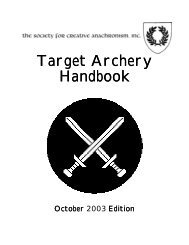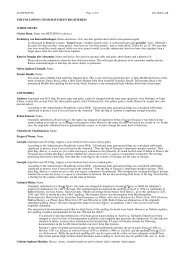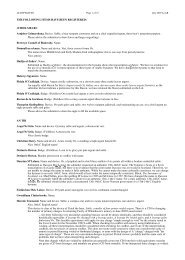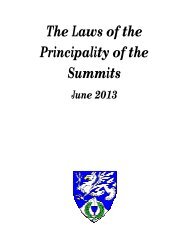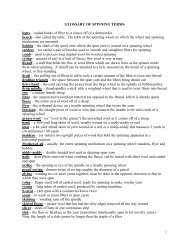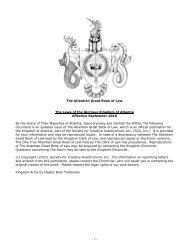The Standards for Evaluation of Names and Armory - SCA Heraldry
The Standards for Evaluation of Names and Armory - SCA Heraldry
The Standards for Evaluation of Names and Armory - SCA Heraldry
You also want an ePaper? Increase the reach of your titles
YUMPU automatically turns print PDFs into web optimized ePapers that Google loves.
<strong>The</strong> <strong>St<strong>and</strong>ards</strong> <strong>for</strong> <strong>Evaluation</strong> <strong>of</strong> <strong>Names</strong> <strong>and</strong> <strong>Armory</strong>:<strong>The</strong> Rules <strong>for</strong> Submissions<strong>and</strong> entirely on the white part <strong>of</strong> the field. For example, both Vair, a chief argent or Checky Or <strong>and</strong> vert,a lozenge vert can be acceptable, if drawn so that the shared tinctures are not against each other.Even if it meets these requirements, a particular depiction may still be unclear as to the identity <strong>of</strong> thefield <strong>and</strong> the charge that lies on it, including whether the charge has a complex line <strong>of</strong> division. Such adepiction will not be registered. In general, any depiction that creates a situation in which predominantlylow contrast sections <strong>of</strong> a multiply divided field <strong>and</strong> charge(s) are adjacent is likely to have identifiabilityissues.For example, if the design Vair, a chief argent were drawn so that the vair bells against the chief werenearly completely argent, it would be difficult to identify the charge as a chief, <strong>and</strong> whether or not it hadea complex line. <strong>The</strong>re<strong>for</strong>e, it would not be registerable.Similarly, when a primary charge <strong>and</strong> an overall charge that overlies it share a tincture or have poorcontrast (which will generally be true), the identity <strong>of</strong> the primary charge <strong>and</strong> the overall charge mustremain clear.C. Voiding <strong>and</strong> Fimbriation: Voiding <strong>and</strong> fimbriation are terms that describe the situation in which the interior<strong>of</strong> the charge is a different color than a strip around the outside <strong>of</strong> the charge. <strong>The</strong> term voiding is used <strong>for</strong>the case in which the interior part <strong>of</strong> the charge is the same color as the field. <strong>The</strong> term fimbriation is used <strong>for</strong>the case in which the interior part <strong>of</strong> the charge is <strong>of</strong> a different color than the field.Voiding <strong>and</strong> fimbriation may only be used with ordinaries or simple geometric charges when they are part <strong>of</strong>a primary charge group. Peripheral ordinaries may not be voided or fimbriated, nor may other secondary,tertiary, or overall charges. All central ordinaries may be fimbriated, even those with complex lines, as longas there are no breaks in the outline <strong>of</strong> the ordinary. All central ordinaries with more than two ends, such aspalls, crosses, <strong>and</strong> saltires, may be voided, even those with complex lines, as long as there are no breaks inthe outline <strong>of</strong> the ordinary. As central ordinaries with two ends which are voided would give theunmistakable appearance <strong>of</strong> being multiple ordinaries, they may not be voided.For example, both a cross <strong>and</strong> a cross engrailed may be either voided or fimbriated. However, a fess mayonly be fimbriated; a design that appears to be a fess voided must be blazoned as two bars. For example, apale rayonny <strong>and</strong> a fess dancetty may be fimbriated, while a chevron rompu or a bend bevilled may not befimbriated, as the latter are broken in their outlines.A simple geometric charge is a charge that, when drawn at a smaller scale, will continue to match the outline<strong>of</strong> the larger charge closely. Simple geometric charges include lozenges, roundels, delfs, <strong>and</strong> mullets.However, as counter examples, estoiles <strong>and</strong> suns are not simple.Voiding <strong>and</strong> fimbriation is generally used with a single central charge. For this reason, using voiding orfimbriation with charge groups that contain more than three charges will only be registered withdocumentation <strong>of</strong> such a pattern. Additionally, voided charges may not be registered in fieldless designs, asthey do not have a field that can show through the voided portion <strong>of</strong> the charge.For example, a design such as Azure, three delfs voided Or would be registered, but Azure semy <strong>of</strong> delfsvoided Or would not be. Also, while Azure, a mullet voided argent is registerable, (Fieldless) A mullet voidedargent is not, as the voided area would not have a defined tincture.Charges which are voided as part <strong>of</strong> their type, such as mascles or mullets voided <strong>and</strong> interlaced, are notaffected by these restrictions. <strong>The</strong>y may even be tertiary charges or maintained charges, <strong>and</strong> may be used infieldless designs.<strong>St<strong>and</strong>ards</strong> <strong>for</strong> <strong>Evaluation</strong> <strong>of</strong> <strong>Names</strong> <strong>and</strong> <strong>Armory</strong> – April 29, 2012 - Page 44 <strong>of</strong> 73



